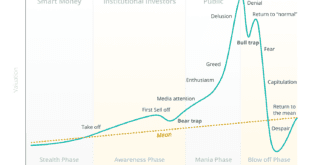The Dow Jones Industrial Average (DJIA) Index – the oldest stock exchange in the  U.S. and most influential in the world – consists of 30 companies and has an extremely interesting and distressing history regarding its beginnings, transformation and structural development which has all the trappings of what is commonly referred to as pyramid or Ponzi scheme.
U.S. and most influential in the world – consists of 30 companies and has an extremely interesting and distressing history regarding its beginnings, transformation and structural development which has all the trappings of what is commonly referred to as pyramid or Ponzi scheme.
So writes Wim Grommen in an article originally posted on www.munKNEE.com entitled Beware: The Dow 30’s Performance is Being Manipulated!
Please read details on how to contribute to the DOWDIVISOR30 campaign at the end of this article.
Grommen goes on to say, and I quote:
The Dow Index was first published in 1896 when it consisted of just 12 constituents and was a simple price average index in which the sum total value of the shares of the 12 constituents were simply divided by 12. As such those shares with the highest prices had the greatest influence on the movements of the index as a whole. In 1916 the Dow 12 became the Dow 20 with four companies being removed from the original twelve and twelve new companies being added. In October, 1928 the Dow 20 became the Dow 30 but the calculation of the index was changed to be the sum of the value of the shares of the 30 constituents divided by what is known as the Dow Divisor.
While the inclusion of the Dow Divisor may have seemed totally straightforward it was – and still is – anything but! Why so? Because every time the number of, or specific constituent, companies change in the index any comparison of the new index value with the old index value is impossible to make with any validity whatsoever. It is like comparing the taste of a cocktail of fruits when the number of different fruits and their distinctive flavours – keep changing. Let me explain the aforementioned as it relates to the Dow.
Companies Go Through 5 Transition Phases
On one hand, generally speaking, the companies that are removed from the index are in either the stabilization or degeneration transition phases of which there are five, namely:
1. the pre-development phase in which the present status does not visibly change.
2. the take-off phase in which the process of change starts because of changes to the system
3. the acceleration phase in which visible structural changes – social, cultural, economical, ecological, institutional – influence each other
4. the stabilization phase in which the speed of sociological change slows down and a new dynamic is achieved through learning.
5. the degeneration phase in which costs rise because of over-capacity leading to the producing company finally withdrawing from the market.
The Dow Index is a Pyramid Scheme
On the other hand, companies in the take-off or acceleration phase are added to the index. This greatly increases the chances that the index will always continue to advance rather than decline. In fact, the manner in which the Dow index is maintained actually creates a kind of pyramid scheme! All goes well as long as companies are added that are in their take-off or acceleration phase in place of companies in their stabilization or degeneration phase.
The False Appreciation of the Dow Explained
On October 1st, 1928, when the Dow was enlarged to 30 constituents, the calculation formula for the index was changed to take into account the fact that the shares of companies in the Index split on occasion. It was determined that, to allow the value of the Index to remain constant, the sum total of the share values of the 30 constituent companies would be divided by 16.67 ( called the Dow Divisor) as opposed to the previous 30.
On October 1st, 1928 the sum value of the shares of the 30 constituents of the Dow 30 was $3,984 which was then divided by 16.67 rather than 30 thereby generating an index value of 239 (3984 divided by 16.67) instead of 132.8 (3984 divided by 30) representing an increase of 80% overnight!! This action had the affect of putting dramatically more importance on the absolute dollar changes of those shares with the greatest price changes. But it didn’t stop there!
On September, 1929 the Dow divisor was adjusted yet again. This time it was reduced even further down to 10.47 as a way of better accounting for the change in the deletion and addition of constituents back in October, 1928 which, in effect, increased the October 1, 1928 index value to 380.5 from the original 132.8 for a paper increase of 186.5%!!!
From September, 1929 onwards (at least for a while) this “adjustment” had the affect – and I repeat myself – of putting even that much more importance on the absolute dollar changes of those shares with the greatest changes.
How the Dow Divisor Contributed to the Crash of ‘29
From the above analyses/explanation it is evident that the dramatic “adjustments” to the Dow Divisor (coupled with the addition/deletion of constituent companies according to which transition phase they were in) were major contributors to the dramatic increase in the Dow from 1920 until October 1929 and the following dramatic decrease in the Dow 30 from then until 1932 notwithstanding the economic conditions of the time as well.
Exponential Rise in the Dow 30 is Revealed
The 1980s and ‘90s saw a continuation of the undermining of the true value of the Dow 30. Yes – you guessed correctly –further “adjustments” in the Dow Divisor kept coming and coming! As the set of constituents of the Dow changed over the years (almost all of them) and many shares were split the Dow Divisor kept changing.
By 1985 the Dow Divisor was only 1.116 and today, as of the open of the market on Tuesday, September 3rd, the current divisor for the Dow Jones Industrial Average, as found on page C4 of the Wall St. Journal, is only 0.130216081.
[On Friday, August 30th, 2013 the Dow Jones Industrial Average closing numerator was 1928.54. This is the sum of all 30 closing prices. A short cut to the Dow numerator is to multiply the closing Dow by the Divisor. Now, if you divide the Dow numerator change for today by the divisor (0.130216081) you get the change in today’s Dow. A dollar increase or decrease in a Dow stock results in a $7.68 change in the Dow Index.The average closing price (the closing numerator divided by 30) of last Friday’s Dow Jones Industrial Average was $64.28. That’s right, $64.28 (1928.54 divided by 30). That is to say that IF we were still using the original formula the Dow 30 would actually be only 64.28 (1928.54 divided by 30)!
The crucial questions today are:
1. Is the current underlying economy strong enough to keep the Dow 30 at its present level?
2. Will the 30 constituents of the Dow remain robust or evolve into the stabilization and degeneration phases?
3. Will there be enough new companies to act as new “up-lifters” of the Dow?
4. When will the Dow Divisor change – yet again??
The Dow 30 is the Greatest of All Ponzi Schemes
I call on the financial community to take a critical look at the Dow Divisor. If it is retained investors will continue to be deceived with every new transition from one phase to another and the greatest of all Ponzi schemes will have major financial consequences for every investor.
(A version of this article, entitled Beurskrach 1929, mysterie ontrafeld?, was first published in Dutch in the January 2010 issue of “Technische en Kwantitatieve Analyse” magazine which is a monthly publication of Beleggers Belangen (Investment Interests) in the Netherlands and on several sites there including: Beurskrach 1929 mysterie ontrafeld? op Historiek.net)
Please join the DOWDIVISOR30 International Campaign to restore the Dow Divisor in the formula used to calculate the Dow Jones to its original value of 30! Here’s how:
The DOWDIVISOR30 campaign will start shortly and is intended to convince the people responsible for the composition of the Dow Jones – a number of journalists employed by the Wall Street Journal and S & P Dow Jones Indices LLC, a subsidiary of The McGraw-Hill Companies, the owner of the Dow Jones Index – to restore the Dow Divisor in the formula used to calculate the Dow Jones to its original value of 30.
A petition is being drawn up which will be distributed worldwide requesting that President Obama’s administration exert pressure on the above mentioned entities to carry out this change in the Dow Jones formula.
The campaign will have an educational component in that it will draw attention to the following articles and paper with the intent of assisting those who read them in making an informed decision regarding the petition:
- The article Market crash 1929, mystery unraveled? describes what happened to the Dow Jones behind the scenes at the time of the stock market crash in 1929.
- The article Without knowledge of the past there is no future shows graphs of the stock market which illustrate that the indexes provide no relevant long-term information.
- The article Will Obama manipulate the Dow Divisor, from fiction to reality? clearly explains why it is a good idea to make this change to the Dow Jones formula.
- A paper entitled “THE ECONOMIC CRISIS: TIME FOR A PARADIGM SHIFT” – The present crisis, a pattern which was recently presented at an international symposium in Valencia, Spain outlining the need to make the change to the Dow Jones formula in the near future.
Become a “Friend of the Campaign”! Here’s how:
The campaign is currently in the process of collecting golden, silver and bronze friends who are prepared to support DOWDIVISOR30 as follows:
- A golden friend is someone who signs the petition and draws as much attention as possible to the campaign via social media.
- A silver friend is someone who signs the petition.
- A bronze friend is a website or organisation which draws attention to the DOWDIVISOR30 campaign.
As soon as the list of friends has achieved a respectable size, the campaign will officially start. If you are interested in becoming a “friend of the campaign” please contact me, Wim Grommen, via Twitter: #DOWDIVISOR30, #DDD of #DDT or via email to editor (at) munKNEE (dot) com and your offer of support will be forwarded to Wim.
 munKNEE.com Your Key to Making Money
munKNEE.com Your Key to Making Money



Good article, like many other indexes being changed only makes the information and charts people use “appear” to show what the Fed and Central Bankers what them too!
When the US Gov’t. said that the 2013 COLA was only 1.7% it told me that that calculation is also suspect because it is easily twice if not three time that amount.
Investors need to look at the “fine print” and compare todays numbers with past numbers using the same metrics, if they want an Apple to Apple comparison.